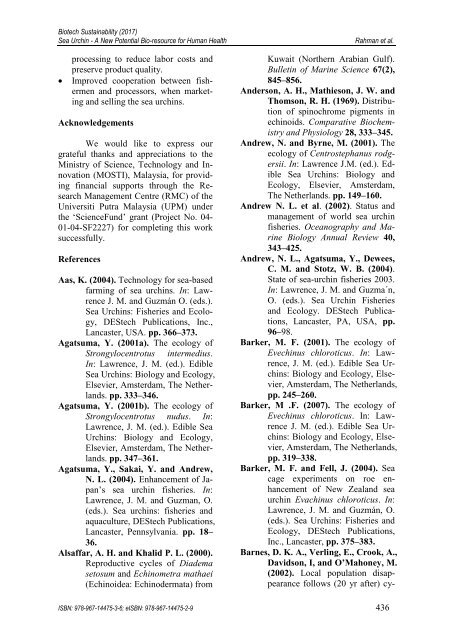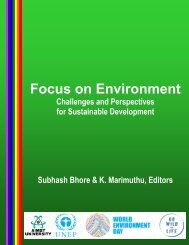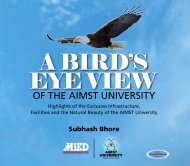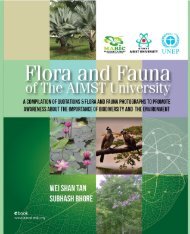Biotechnology for Sustainability: Achievements, Challenges and Perspectives
World Environment Day (WED) is a global annual event celebrated each year on June 5 to promote the awareness about the importance of preserving the environment. This book is published to commemorate the world environment day-2017 (WED-2017). The main purpose of this book is to highlight – how biotechnology can contribute for the sustainable development and in achieving sustainable development goals (SDGs) adapted by the international community to improve the health of people and planet? This book contains 38 full-length articles contributed by various researchers, scientists and academicians. A prudent use of biotechnology in the biodiversity conservation, environmental protection, and production of more and better quality of food, fiber, fuel and drugs will contribute in achieving SDGs and to promote the peace in the world. This book will serve as a reference to various researchers, scientists, academicians and students involved in biodiversity conservation, environmental protection and various fields of biology and biotechnology.
World Environment Day (WED) is a global annual event celebrated each year on June 5 to promote the awareness about the importance of preserving the environment. This book is published to commemorate the world environment day-2017 (WED-2017). The main purpose of this book is to highlight – how biotechnology can contribute for the sustainable development and in achieving sustainable development goals (SDGs) adapted by the international community to improve the health of people and planet? This book contains 38 full-length articles contributed by various researchers, scientists and academicians. A prudent use of biotechnology in the biodiversity conservation, environmental protection, and production of more and better quality of food, fiber, fuel and drugs will contribute in achieving SDGs and to promote the peace in the world. This book will serve as a reference to various researchers, scientists, academicians and students involved in biodiversity conservation, environmental protection and various fields of biology and biotechnology.
Create successful ePaper yourself
Turn your PDF publications into a flip-book with our unique Google optimized e-Paper software.
Biotech <strong>Sustainability</strong> (2017)<br />
Sea Urchin - A New Potential Bio-resource <strong>for</strong> Human Health<br />
<br />
processing to reduce labor costs <strong>and</strong><br />
preserve product quality.<br />
Improved cooperation between fishermen<br />
<strong>and</strong> processors, when marketing<br />
<strong>and</strong> selling the sea urchins.<br />
Acknowledgements<br />
We would like to express our<br />
grateful thanks <strong>and</strong> appreciations to the<br />
Ministry of Science, Technology <strong>and</strong> Innovation<br />
(MOSTI), Malaysia, <strong>for</strong> providing<br />
financial supports through the Research<br />
Management Centre (RMC) of the<br />
Universiti Putra Malaysia (UPM) under<br />
the „ScienceFund‟ grant (Project No. 04-<br />
01-04-SF2227) <strong>for</strong> completing this work<br />
successfully.<br />
References<br />
Aas, K. (2004). Technology <strong>for</strong> sea-based<br />
farming of sea urchins. In: Lawrence<br />
J. M. <strong>and</strong> Guzmán O. (eds.).<br />
Sea Urchins: Fisheries <strong>and</strong> Ecology,<br />
DEStech Publications, Inc.,<br />
Lancaster, USA. pp. 366–373.<br />
Agatsuma, Y. (2001a). The ecology of<br />
Strongylocentrotus intermedius.<br />
In: Lawrence, J. M. (ed.). Edible<br />
Sea Urchins: Biology <strong>and</strong> Ecology,<br />
Elsevier, Amsterdam, The Netherl<strong>and</strong>s.<br />
pp. 333–346.<br />
Agatsuma, Y. (2001b). The ecology of<br />
Strongylocentrotus nudus. In:<br />
Lawrence, J. M. (ed.). Edible Sea<br />
Urchins: Biology <strong>and</strong> Ecology,<br />
Elsevier, Amsterdam, The Netherl<strong>and</strong>s.<br />
pp. 347–361.<br />
Agatsuma, Y., Sakai, Y. <strong>and</strong> Andrew,<br />
N. L. (2004). Enhancement of Japan‟s<br />
sea urchin fisheries. In:<br />
Lawrence, J. M. <strong>and</strong> Guzman, O.<br />
(eds.). Sea urchins: fisheries <strong>and</strong><br />
aquaculture, DEStech Publications,<br />
Lancaster, Pennsylvania. pp. 18–<br />
36.<br />
Alsaffar, A. H. <strong>and</strong> Khalid P. L. (2000).<br />
Reproductive cycles of Diadema<br />
setosum <strong>and</strong> Echinometra mathaei<br />
(Echinoidea: Echinodermata) from<br />
Rahman et al.<br />
Kuwait (Northern Arabian Gulf).<br />
Bulletin of Marine Science 67(2),<br />
845–856.<br />
Anderson, A. H., Mathieson, J. W. <strong>and</strong><br />
Thomson, R. H. (1969). Distribution<br />
of spinochrome pigments in<br />
echinoids. Comparative Biochemistry<br />
<strong>and</strong> Physiology 28, 333–345.<br />
Andrew, N. <strong>and</strong> Byrne, M. (2001). The<br />
ecology of Centrostephanus rodgersii.<br />
In: Lawrence J.M. (ed.). Edible<br />
Sea Urchins: Biology <strong>and</strong><br />
Ecology, Elsevier, Amsterdam,<br />
The Netherl<strong>and</strong>s. pp. 149–160.<br />
Andrew N. L. et al. (2002). Status <strong>and</strong><br />
management of world sea urchin<br />
fisheries. Oceanography <strong>and</strong> Marine<br />
Biology Annual Review 40,<br />
343–425.<br />
Andrew, N. L., Agatsuma, Y., Dewees,<br />
C. M. <strong>and</strong> Stotz, W. B. (2004).<br />
State of sea-urchin fisheries 2003.<br />
In: Lawrence, J. M. <strong>and</strong> Guzma´n,<br />
O. (eds.). Sea Urchin Fisheries<br />
<strong>and</strong> Ecology. DEStech Publications,<br />
Lancaster, PA, USA, pp.<br />
96–98.<br />
Barker, M. F. (2001). The ecology of<br />
Evechinus chloroticus. In: Lawrence,<br />
J. M. (ed.). Edible Sea Urchins:<br />
Biology <strong>and</strong> Ecology, Elsevier,<br />
Amsterdam, The Netherl<strong>and</strong>s,<br />
pp. 245–260.<br />
Barker, M .F. (2007). The ecology of<br />
Evechinus chloroticus. In: Lawrence<br />
J. M. (ed.). Edible Sea Urchins:<br />
Biology <strong>and</strong> Ecology, Elsevier,<br />
Amsterdam, The Netherl<strong>and</strong>s,<br />
pp. 319–338.<br />
Barker, M. F. <strong>and</strong> Fell, J. (2004). Sea<br />
cage experiments on roe enhancement<br />
of New Zeal<strong>and</strong> sea<br />
urchin Evachinus chloroticus. In:<br />
Lawrence, J. M. <strong>and</strong> Guzmán, O.<br />
(eds.). Sea Urchins: Fisheries <strong>and</strong><br />
Ecology, DEStech Publications,<br />
Inc., Lancaster, pp. 375–383.<br />
Barnes, D. K. A., Verling, E., Crook, A.,<br />
Davidson, I, <strong>and</strong> O’Mahoney, M.<br />
(2002). Local population disappearance<br />
follows (20 yr after) cy-<br />
ISBN: 978-967-14475-3-6; eISBN: 978-967-14475-2-9 436







